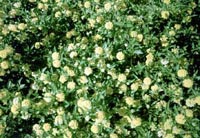Resource Library
Plant of the Week: New Gold Lantana
The University of Arkansas System Division of Agriculture does not promote, support or recommend plants featured in "Plant of the Week." Please consult your local Extension office for plants suitable for your region.
Plant of the Week
New Gold Lantana
Latin: Lantana camara 'New Gold'

Finding bedding plants that bloom from April through June is easy, but gardeners fancying
annual flowers that actually prefer Arkansas weather in July and August is a bit harder.
Lantana is one of those maverick plants that actually does best when it gets so hot
and miserable outside that all but the most dedicated gardeners call a two month hiatus
to await more hospitable conditions. New Gold, a compact, free-flowering lantana with
golden-yellow blooms, will bloom its heart out as we enrich the electric company.
New Gold is a 2000 Arkansas Select plant that was chosen by a coalition of individuals
from the University of Arkansas Horticulture Department, the Cooperative Extension
Service and the Arkansas Nurseryman’s Association. Criteria for designation as an
Arkansas Select plant are simple; it must perform well in all parts of the state and
it must be fairly easy to find in the landscape trade. Most Arkansas nurseries and
greenhouses will have New Gold this spring.
New Gold Lantana is a semi-hardy perennial that is best treated as an annual in the
garden. It grows 1 foot tall and 2 feet wide and is covered with yellow-gold, 2-inch
clusters of blooms which are produced above the foliage. Lantanas bloom in a dense
head with individual florets tubular, with four or five lobes.
Some lantana selections produce clusters of black berries which are considered poisonous,
but New Gold is almost completely fruitless. The poisonous properties are considered
of importance to ranchers because in subtropical areas of Florida, Texas and Hawaii
lantana has escaped into pasture lands. No reports of human death have ever been attributed
to lantana berries.
The genus lantana consists of over 150 species, mostly of tropical parts of the Americas
from which this species originates. It has long been cultivated as an ornamental,
but French breeders developed the modern forms in the color ranges we know today at
the close of the 19th century. New Gold is of more recent vintage, with it being one
of the 40 to 50 cultivars of this plant that are in the trade. Allan Armitage, the
garden plant guru from the University of Georgia, was the first to highlight the merits
of New Gold around 1995.
While lantanas will sometimes overwinter, especially when sited next to the house
in a well drained soil, it is easier to think of them as an annual and replace them
each season. The old plants can be dug in the fall as frost approaches and plants
overwintered in a sunny window or greenhouse. New cuttings should be taken from these
plants in February for late April planting.
New Gold Lantana should be used en masse in the garden in sunny beds large enough
to have an impact on you and the butterflies that frequent it. In flower beds, it
should be spaced 16 to 18 inches apart in any reasonable garden soil.
Lantanas love the heat, so plant them when you plant caladiums, not cool soil tolerant
plants such as petunia and snapdragon. For gardeners wishing to spice up the planting,
consider placing a few Blue Bedder salvia in the midst of the low growing New Gold
for some color contrast and vertical accents.
Lantana blooms are self cleaning, so once planted little work is required, except
for the occasional watering during extreme droughts. Whiteflies are the only serious
pest, and they don’t especially like July and August either, so lantanas usually outgrow
most early season outbreaks.
By: Gerald Klingaman, retired
Extension Horticulturist - Ornamentals
Extension News - May 12, 2000
The University of Arkansas System Division of Agriculture does not maintain lists of retail outlets where these plants can be purchased. Please check your local nursery or other retail outlets to ask about the availability of these plants for your growing area.